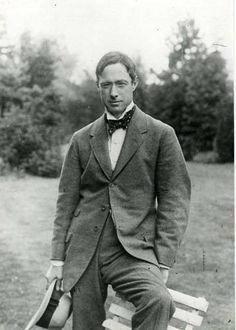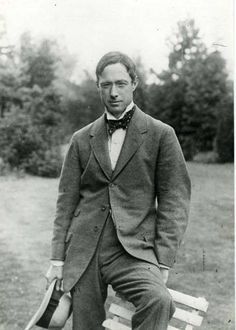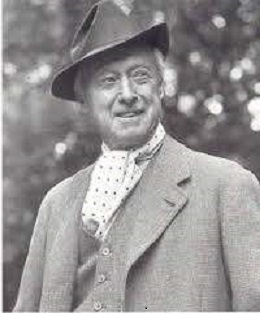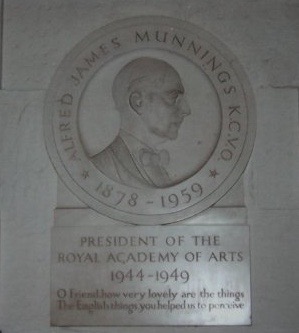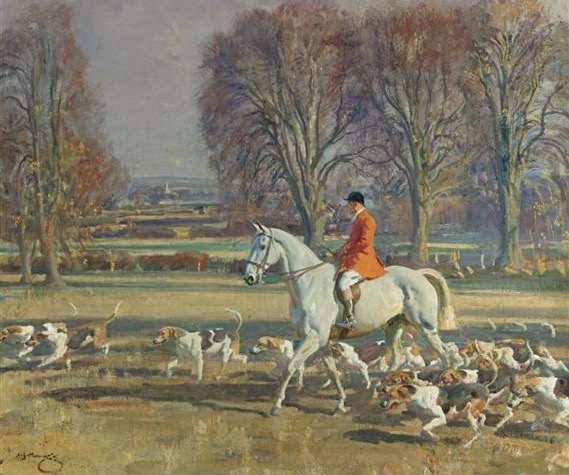Alfred Munnings was born on 8 October 1878 at Mendham Mill, Suffolk, across the River Waveney from Harleston. His father was the miller and Alfred grew up surrounded by the activity of a busy working mill and farm. Realizing that Alfred was artistically gifted, his parents sent him to Framlingham College, but he left the school at the age of fourteen and was apprenticed to a Norwich printer, designing and drawing advertising posters for local businesses like Colman's Mustard and Caley's Crackers. He also attended the Norwich School of Art. When his apprenticeship ended, he studied at Académie Julian in Paris and became a full-time painter.
The loss of sight in his right eye when lifting a hound over a hedge in 1898 did not deflect his determination to paint. In 1899 two of his pictures were shown at the Royal Academy Summer Exhibition. He painted rural scenes of gypsies, cattle and foxhunting in his native East Anglia, but worked and lived in Lamorna, Cornwall for a time, where he was associated with the Newlyn School of painters. While there, he met Florence Carter-Wood (1888–1914), a young horsewoman and painter. They married on 19 January 1912 but she tried to kill herself on their honeymoon and successfully took her own life in 1914.
Munnings bought Castle House, Dedham, Essex in 1919, describing it as 'the house of my dreams', and married another horsewoman, Violet McBride, on June 13, 1920. He lived out the rest of his life at Castle House, and had his studio moved there from Mendham. When the house was requisitioned by the army during the Second World War, the Munnings retreated to Lady Violet's hunt box in Withypool on Exmoor, returning to Dedham at war's end. Lady Violet opened the house as a memorial to her husband following his death on July 17, 1959. There were no children from either of Munnings' marriages.
Lady Violet Munnings encouraged her husband to accept commissions from society figures, both in the UK and in the United States. Toward the end of his career, he painted a number of horseracing scenes at Newmarket. Munnings was also an accomplished sculptor, although he had no formal training in the discipline. His first public work was the memorial equestrian statue of Edward Horner in Mells, Somerset, a collaboration with his friend Sir Edwin Lutyens, who designed the plinth for the statue. This work led to a commission from the Jockey Club for a sculpture of the racehorse, Brown Jack.
Munnings was elected president of the Royal Academy of Arts in 1944. He was made a Knight Bachelor in 1944, and appointed a Knight Commander of the Royal Victorian Order in the 1947 New Year Honours. His presidency is best known for the valedictory speech he gave in 1949, in which he attacked modernism. The broadcast was heard by millions of listeners on BBC radio. In the speech, Munnings claimed that the work of Cézanne, Matisse and Picasso had corrupted art. He recalled that Winston Churchill (who was present at the banquet) had once said to him, "Alfred, if you met Picasso coming down the street would you join with me in kicking his ... something something?" to which Munnings replied, "Yes Sir, I would".
Munnings published an anthology of poetry, wich was praised by his friend the poet laureate, John Masefield (who wrote the epitaph for Munnings' marker in St Paul's Cathedral crypt). He also authored a three-volume autobiography, titled: "An Artist's Life", "The Second Burst" and "The Finish".
Alfred Munnings was born on 8 October 1878 at Mendham Mill, Suffolk, across the River Waveney from Harleston. His father was the miller and Alfred grew up surrounded by the activity of a busy working mill and farm. Realizing that Alfred was artistically gifted, his parents sent him to Framlingham College, but he left the school at the age of fourteen and was apprenticed to a Norwich printer, designing and drawing advertising posters for local businesses like Colman's Mustard and Caley's Crackers. He also attended the Norwich School of Art. When his apprenticeship ended, he studied at Académie Julian in Paris and became a full-time painter.
The loss of sight in his right eye when lifting a hound over a hedge in 1898 did not deflect his determination to paint. In 1899 two of his pictures were shown at the Royal Academy Summer Exhibition. He painted rural scenes of gypsies, cattle and foxhunting in his native East Anglia, but worked and lived in Lamorna, Cornwall for a time, where he was associated with the Newlyn School of painters. While there, he met Florence Carter-Wood (1888–1914), a young horsewoman and painter. They married on 19 January 1912 but she tried to kill herself on their honeymoon and successfully took her own life in 1914.
Munnings bought Castle House, Dedham, Essex in 1919, describing it as 'the house of my dreams', and married another horsewoman, Violet McBride, on June 13, 1920. He lived out the rest of his life at Castle House, and had his studio moved there from Mendham. When the house was requisitioned by the army during the Second World War, the Munnings retreated to Lady Violet's hunt box in Withypool on Exmoor, returning to Dedham at war's end. Lady Violet opened the house as a memorial to her husband following his death on July 17, 1959. There were no children from either of Munnings' marriages.
Lady Violet Munnings encouraged her husband to accept commissions from society figures, both in the UK and in the United States. Toward the end of his career, he painted a number of horseracing scenes at Newmarket. Munnings was also an accomplished sculptor, although he had no formal training in the discipline. His first public work was the memorial equestrian statue of Edward Horner in Mells, Somerset, a collaboration with his friend Sir Edwin Lutyens, who designed the plinth for the statue. This work led to a commission from the Jockey Club for a sculpture of the racehorse, Brown Jack.
Munnings was elected president of the Royal Academy of Arts in 1944. He was made a Knight Bachelor in 1944, and appointed a Knight Commander of the Royal Victorian Order in the 1947 New Year Honours. His presidency is best known for the valedictory speech he gave in 1949, in which he attacked modernism. The broadcast was heard by millions of listeners on BBC radio. In the speech, Munnings claimed that the work of Cézanne, Matisse and Picasso had corrupted art. He recalled that Winston Churchill (who was present at the banquet) had once said to him, "Alfred, if you met Picasso coming down the street would you join with me in kicking his ... something something?" to which Munnings replied, "Yes Sir, I would".
Munnings published an anthology of poetry, wich was praised by his friend the poet laureate, John Masefield (who wrote the epitaph for Munnings' marker in St Paul's Cathedral crypt). He also authored a three-volume autobiography, titled: "An Artist's Life", "The Second Burst" and "The Finish".
Family Members
Sponsored by Ancestry
Advertisement
Records on Ancestry
Advertisement
